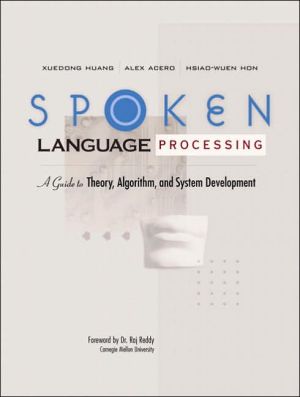

 |

|

Sold Out
Book Categories |
(NOTE: Each chapter ends with Historical Perspective and Further Reading.)
1. Introduction.
Motivations. Spoken Language System Architecture. Book Organization. Target Audiences.
I. FUNDAMENTAL THEORY.
2. Spoken language Structure.
Sound and Human Speech Systems. Phonetics and Phonology. Syllables and Words. Syntax and Semantics.
3. Probability, Statistics, and Information Theory.
Probability Theory. Estimation Theory. Significance Testing. Information Theory.
4. Pattern Recognition.
Bayes' Decision Theory. How to Construct Classifiers. Discriminative Training. Unsupervised Estimation Methods. Classification and Regression Trees.
II. SPEECH PROCESSING.
5. Digital Signal Processing.
Digital Signals and Systems. Continuous-Frequency Transforms. Discrete-Frequency Transforms. Digital Filters and Windows. Digital Processing of Analog Signals. Multirate Signal Processing. Filterbanks. Stochastic Processes.
6. Speech Signal Representations.
Short-Time Fourier Analysis. Acoustical Model of Speech Production. Linear Predictive Coding. Cepstral Processing. Perceptually Motivated Representations. Formant Frequencies. The Role of Pitch.
7. Speech Coding.
Speech Coders Attributes. Scalar Waveform Coders. Scalar Frequency Domain Coders. Code Excited Linear Prediction (CELP). Low-Brit Speech Coders.
III. SPEECH RECOGNITION.
8. Hidden Markov Models.
The Markov Chain. Definition of the Hidden Markov Model. Continuous and Semicontinuous HMMs. Practical Issues in Using HMMs. HMM Limitations.
9. Acoustic Modeling.
Variability in the Speech Signal. How to Measure Speech Recognition Errors. Signal Processing—Extracting Features. Phonectic Modeling—Selecting Appropriate Units. Acoustic Modeling—Scoring Acoustic Features. Adaptive Techniques—Minimizing Mismatches. Confidence Measures: Measuring the Reliability. Other Techniques. Case Study: Whisper.
10. Environmental Robustness.
The Acoustical Environment. Acoustical Transducers. Adaptive Echo Cancellation (AEC). Multimicrophone Speech Enhancement. Environment Compensation Preprocessing. Environment Model Adaptation. Modeling Nonstationary Noise.
11. Language Modeling.
Formal Language Theory. Stochastic Language Models. Complexity Measure of Language Models. N-Gram Smoothing. Adaptive Language Models. Practical Issues.
12. Basic Search Algorithms.
Basic Search Algorithms. Search Algorithms for Speech Recognition. Language Model States. Time-Synchronous Viterbi Beam Search. Stack Decoding (A Search).
13. Large-Vocabulary Search Algorithms.
Efficient Manipulation of a Tree Lexicon. Other Efficient Search Techniques. N-Best and Multipass Search Strategies. Search-Algorithm Evaluation. Case Study—Microsoft Whisper.
IV. TEXT-TO-SPEECH SYSTEMS.
14. Text and Phonetic Analysis.
Modules and Data Flow. Lexicon. Document Structured Detection. Text Normalization. Linguistic Analysis. Homograph Disambiguation. Morphological Analysis. Letter-to-Sound Conversion. Evaluation. Case Study: Festival.
15. Prosody.
The Role of Understanding. Prosody Generation Schematic. Speaking Style. Symbolic Prosody. Duration Assignment. Pitch Generation. Prosody Markup Languages. Prosody Evaluation.
16. Speech Synthesis.
Attributes of Speech Synthesis. Formant Speech Synthesis. Concatenative Speech Synthesis. Prosodic Modification of Speech. Source-Filter Models for Prosody Modification. Evaluation of TTS Systems.
V. SPOKEN LANGUAGE SYSTEMS.
17. Spoken Language Understanding.
Written vs. Spoken Languages. Dialog Structure. Semantic Representation. Sentence Interpretation. Discourse Analysis. Dialog Management. Response Generation and Rendition. Evaluation. Case Study—Dr. Who.
18. Applications and User Interfaces.
Application Architecture. Typical Applications. Speech Interface Design. Internationalization. Case Study—MIPAD.
Index.
Login|Complaints|Blog|Games|Digital Media|Souls|Obituary|Contact Us|FAQ
CAN'T FIND WHAT YOU'RE LOOKING FOR? CLICK HERE!!! X
 You must be logged in to add to WishlistX
 This item is in your Wish ListX
 This item is in your CollectionSpoken Language Processing: A Guide to Theory, Algorithm and System Development
X
 This Item is in Your InventorySpoken Language Processing: A Guide to Theory, Algorithm and System Development
X
 You must be logged in to review the productsX
 X
 X

Add
Spoken Language Processing: A Guide to Theory, Algorithm and System Development,
X
 X

Add
Spoken Language Processing: A Guide to Theory, Algorithm and System Development,
|